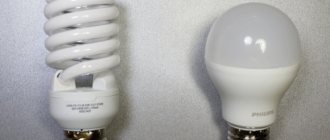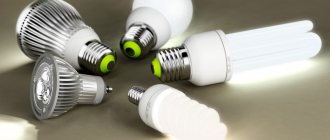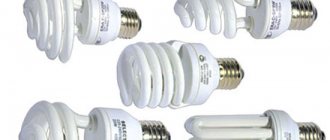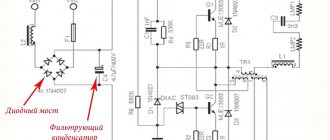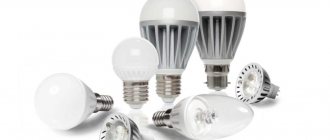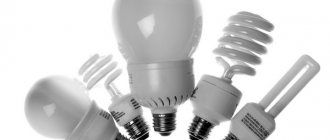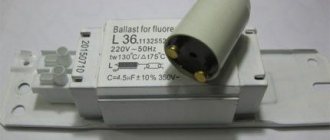03/16/2016 master
Today, lighting is an essential detail of the interior design of a house or apartment. Therefore, it is very important that the chosen lighting fixture provides the required level of illumination in the room. But in addition to this, it is necessary to take into account the possible harm to health that the selected light source can cause during its operation. In many homes at the moment, fluorescent light bulbs are actively used as a source of daylight.
Fluorescent Lamp
In this article we will touch upon the question of how serious the harm of fluorescent lamps is to the human body.
Operating principle of the lamp
Structurally, any “housekeeper” consists of a glass tube containing mercury vapor, and the inside of the walls is coated with a phosphor. Under the influence of an electric current, mercury vapor begins to emit an ultraviolet glow, which is converted into light visible to humans using a phosphor.
There are several types of lamps, differing in shape, but they all use the same principle.
There are two main reasons why consumers prefer energy-saving lamps to conventional ones:
- Low electrical energy consumption.
- High luminous efficiency (approximately five times greater).
The most common are compact fluorescent lamps. The new product is not dangerous for people. With a high-quality phosphor, protective coating, structural integrity and technically correct processing of glass surfaces, there will be no harm. The opposite picture is observed when at least one of these conditions is violated.
Precautionary measures
Fluorescent lamps are considered harmful when a low-quality product is purchased, as well as when used incorrectly. To prevent the negative effects of devices on the body, it is important to follow simple rules:
- You should not purchase products of questionable quality.
- Do not use products for table lamps, bedside lamps, sconces and other devices that are located near a person.
- You should not use light bulbs in children's rooms, as they negatively affect the retina of the eyes, which is not yet fully formed, as well as the skin.
- Do not hold the lamp by the bulb while screwing or unscrewing, otherwise the seal may break.
- It is important to comply with the operating standards of the product.
- It is necessary to promptly change used devices so that flicker and ultraviolet radiation do not negatively affect the body.
Health effects
In an attempt to save money, manufacturers of energy-saving lamps forget about their potential danger to humans and the environment. They try:
- use cheap parts and phosphor;
- remove important elements (for example, capacitors) or coating intended to protect against ultraviolet rays from the circuits;
- ensure speedy assembly, often of poor quality.
Mercury vapor poisoning
If the integrity of the lamp is compromised, mercury vapor immediately envelops the lamp, forming an invisible toxic cloud. This substance in a gaseous state enters the body through the respiratory tract and leads to poisoning, which, in turn, leads to death. Pregnant women and young children are at risk. In addition, mercury enters the body through pores on the skin.
Attention! The process of destruction of the body takes a long time. A poisoned person becomes nervous, apathetic, fatigue, cardiac arrhythmia and other processes related to physiology are observed. In such cases, hospitalization is required!
Melatonin production disorder
Melatonin is an important hormone. It is responsible for the body’s biological clock and the need for rest, affects the immune system and prevents the formation of malignant tumors. Scientists have proven that regular exposure to energy-saving lamps reduces the amount of melatonin produced. This is especially true in the dark.
Important! Due to the lack of melatonin, prostate or breast cancer forms.
Harm to the skin and cancer as a consequence
According to American scientists, the most real danger of fluorescent lamps is associated with ultraviolet radiation generated when electrical charges act on the electrodes and mercury vapor. Ultraviolet radiation leads to the death and aging of skin cells, in severe cases – to melanoma (skin cancer).
In addition to melanoma, you may develop:
- allergic rashes;
- psoriasis;
- swelling of skin tissue.
Despite manufacturers' statements about the use of a protective layer that prevents the free passage of ultraviolet rays, research has proven the presence of microcracks on the walls of the highest quality lamps.
Damage to vision
Ultraviolet (UV) radiation also has a damaging effect on the retina of the eye, triggering oxidative processes. Particularly dangerous are fluorescent lamps formed from yellow and blue diodes. The latter are another source of UV rays.
The risk zone includes:
- Young children - their retina is especially sensitive to ultraviolet radiation. The eyeball crystal is the main filter, and in children it is not yet fully formed.
- People with the disease macular degeneration of the retina.
Flicker
One of the important design elements of any energy-saving lamp is a capacitor. It provides uninterrupted lighting. When an electrical product fails, it begins to blink and a flicker that is invisible to the eye appears. Reading books in such light leads to rapid fatigue and fatigue of the visual organs.
Note! Flickering is most dangerous for epileptics - it causes new attacks.
The problem is that cheap “housekeepers” are made without capacitors at all, so they flicker from the very beginning.
Electromagnetic pollution
Damage from light bulbs can be caused by constant switching on and off, which increases electromagnetic pollution. High-frequency interference is generated, and when several lamps are turned on, the network operates under load.
On the other hand, if the lighting fixture is constantly on, then such pollution is out of the question.
Radio frequency radiation
But that’s not all that energy-saving lamps are dangerous for the human body! During the research, it was found that radio frequency radiation from these products spreads over short distances - up to 150 mm. And if the radio frequency waves of a lamp located on the ceiling do not pose a threat to humans, then when using table lamps or sconces, the danger increases.
Important! Such exposure contributes to the destruction of the central nervous system and the development of immune or cardiovascular diseases.
What else are dangerous energy-saving lamps?
Radiation from lamps, as it recently became known, stops the body’s production of melatonin, and this is a very important hormone that is responsible for regulating a person’s life rhythm, i.e., it tells you when to wake up and when it’s time to go to bed. For this reason, a person becomes lethargic, apathetic, and sometimes causeless aggression appears.
In any case, of course, you need to choose which lighting fixtures to use and decide for yourself whether energy-saving light bulbs are harmful. After all, everyone is responsible for their own health. But arguing with facts is a useless exercise.
And yet, mistakes are quite possible, both by scientists and ordinary people. After all, everyone looks at things from their own perspective. And similar lamps are now burning in the majority of apartments, but the majority of humanity is not sick, and therefore there is no point in drawing hasty conclusions.
And besides, the bulk of the research is based on data obtained from the operation of old fluorescent lamps, using not electronic, but ordinary ballasts with a choke. But progress does not stand still, and modern CFLs are quite safe. Of course, you should not break such lamps indoors, but still the amount of harmful substances in them is several times lower than the maximum permissible standards. And therefore, such light bulbs have a right to exist in our apartments.
Disposal
On average, one energy-saving lamp contains 7 mg of mercury. Even with such a small volume, it is highly not recommended to throw them into regular trash containers. The only way out is to send the products to production facilities that process them.
Despite this, they often end up in public landfills. The reason is the reluctance of people to look for such enterprises, as well as to pay money for disposal. Sooner or later this will lead to an environmental disaster.
These lamps are not suitable for residential premises
With the correct selection of energy-saving lamps, you will not feel the difference. Energy-saving lamps have two characteristics:
- Color rendering index
- Colorful temperature
Color temperature from 2700 K to 3500 K is close to daylight, from 3600 K to 4600 K have a cold (bluish) tint.
The color rendering index of energy-saving lamps ranges from 60% to 98%. The higher this number, the better.
Usually on the lamp base there is a marking of three numbers, for example: 827 or 735. 827 means that the lamp has a color rendering index of 80%, a color temperature of 2700 K. 735 means that the lamp has a color rendering index of 70%, a color temperature of 3500 K.
Recommendations
If you still want to use energy-saving lamps, then you need to make every effort to reduce the harm from their use. Remember a few simple rules:
- install lamps exclusively on ceilings, do not use them in bedside lamps or table lamps, the distance to it is at least one meter;
- in case of mechanical damage, immediately ventilate the room;
- put on rubber gloves and use your hands to collect the fragments with drops of mercury (the latter can be collected using a pipette);
- no need to use a broom or vacuum cleaner for this purpose;
- then perform wet cleaning;
- place the rag with mercury and the fragments in a sealed bag;
- Disposal occurs in specially designated areas for toxic waste.
We believe that the danger of energy-saving lamps affecting human health is more than real. But a few simple recommendations, your vigilance, adherence to operating dates and no attempts to save money on the purchase of such products significantly reduce the risk of developing diseases.
Eliminating the consequences of a broken lamp
Not everyone knows what actions to take if a fluorescent lamp breaks. In such cases, you should not panic.
First of all, you need to do the following:
- In the room where the broken lamp was located, you need to open the windows for 1.5 hours to ventilate the room. The room can be left open longer, this will only improve the result and remove mercury faster. Before ventilation, not only people, but also pets must leave the room.
- You should get rid of any fragments and other parts of the lamp as soon as possible. The mercury powder is collected using a damp sponge on a homemade cardboard scoop. The smallest glass fragments are removed from the surface with tape or adhesive tape. Everything removed must be securely closed in a sealed plastic bag.
- After the room has been ventilated, it needs to be wet cleaned. Treatment and disinfection of the floor surface is carried out with an aqueous solution of bleach or potassium permanganate. Washing is carried out in the direction from the edges to the center of the room. This method will allow you to collect the remaining unremoved fragments and mercury.
- Shoe soles must be washed with chlorine solution.
- The used rag is put into a bag, sealed and taken away for recycling or in special bins.
How to use a fluorescent light bulb
If fluorescent light bulbs are used correctly, they will not cause harm. The following few rules will help prevent a fluorescent lamp from breaking:
Safety precautions when working with electrical equipment: general information and basic measures
A fluorescent lamp has been broken: take precautions and dispose of it correctly!
RCD in power supply circuits of drive frequency converters
- Periodically check the light bulbs for their integrity, especially for those light bulbs that have regularly worked for more than one year.
- It is necessary to check the integrity of the light bulbs before screwing them into the lamps. Even if a new light bulb has minor cracks on the bulb, it is better to return it under warranty with a mandatory indication of the reason for the return.
- Careful handling of the light bulb is the key to the integrity of the mercury flask. You only need to screw it in and out by holding it by the body, and under no circumstances apply force to the glass component, because of this the flask may crack right in your hands.
- You cannot use very tight lampshades and shades - energy-saving light bulbs over 10 watts tend to get very hot, which is why in low-quality and defective products the electrical circuit may catch fire, which will lead to physical damage to the bulb and it may even explode.
- Initially, you need to buy products from a trusted company that guarantees the quality of its products. A good manufacturer monitors the production of light bulbs at all stages of the process, so they arrive at the point of sale fully operational and with the appropriate codes and certificates.
High-quality fluorescent lamps must comply with quality certificates
What harm to health can be caused
If you don’t know how to behave if an energy-saving light source is damaged, then you need to at least know what the signs of mercury vapor poisoning are. These include:
- headache, which in its intensity and duration resembles a migraine;
- a metallic taste in the mouth is the main sign of poisoning;
Metallic taste in the mouth - the lamp is to blame
- bleeding gums;
- the appearance of a dry cough;
- fever or chills;
- trembling of fingers.
But such symptoms appear in full only with severe poisoning. Usually, if you at least ventilated the room after such a lamp broke in it, none of the above symptoms will appear. For them to appear, you need to break a sufficient number of products.
Stroboscopic effect
This is the effect that is caused by multiple blinking of a light bulb, invisible to the eye, as a result of which the real movement of objects located in the lighting zone is distorted. What is the harm from energy-saving lamps in this case? And if in everyday life the stroboscopic effect can only bring temporary inconvenience, then in production or when playing sports it can lead to tragedy. The reason is that when illuminated by fluorescent lamps, it seems that the object is in one place, when in fact it has already moved to another.
Flashing lamps lead to fatigue and headaches
There are ways to eliminate this effect, but usually they come down to installing an additional lamp with a different phase.
However, this increases the amount of toxic “energy savers” and is fraught with other negative effects.
It should be noted that if blinking is visible to the naked eye and, as a rule, is observed after turning off the light, then this problem can be solved in completely different ways. You can read about it here.
Who needs a fluorescent lamp?
So, you should get a fluorescent lamp if you:
- Have difficulty getting up in the morning, feel lethargic and sleepy during the day;
- Every autumn you become depressed and irritable;
- You are rarely in the sun, spend all daylight hours indoors;
- With the first autumn cold, you begin to gain weight;
- Take care of your health; you want to preserve your natural beauty and well-being.
The lamp will provide a sufficient amount of daylight, regardless of the season and time of year, will help the body produce vitamin D, and will be a pleasant addition to the interior. This means that you are no longer afraid of the autumn blues and winter depression.
Advice from professionals
Considering that mercury poses a danger to the environment and human health, fluorescent lamps are significantly inferior to LEDs and halogen lamps. Even in European countries, mercury thermometers have long been discontinued. So why take the risk and use fluorescent lamps?
Professionals believe that such lighting devices do not deserve attention, and the only purpose of their creation is a smooth transition from incandescent lamps to LED lamps.
Indeed, the service life of LEDs does not depend on the number of times they are turned on and off; there is no need to wait until the lamp warms up and begins to shine brighter, and they can be disposed of along with other solid waste. High-quality products have the correct color temperature and do not create eye strain.
So, we have learned that not only a compact tubular fluorescent lamp can be called energy-saving.
Currently, it has worthy competitors in this field - LED and halogen lighting devices.
Not so long ago, not everyone could afford to purchase an LED lamp, but today their prices have been reduced and are acceptable to everyone. In addition, the energy savings and long service life quickly pay for the cost of the lamp. Fluorescent lamps are a good option for lighting offices, but for the home it is better to opt for LEDs.
What not to do if a fluorescent lamp breaks
Do not disassemble or repair yourself
Many people, when a light bulb burns out, do not want to buy a new one, but try to fix it with their own hands. Trying to save money. Because in expensive light bulbs the failure is often so small that it can be eliminated by soldering several capacitors. However, it is important to remember that incompetent intervention in the light bulb can lead to depressurization of the bulb, which contains mercury! This is especially dangerous if the toxic substance gets on the skin of your hands. Because there is a high probability of mercury entering the lungs. Therefore, it is advisable to refrain from disassembling the light bulb. You should properly dispose of it and buy a new one, while following all the recommendations in this article.
A list of what else should not be done if a fluorescent lamp breaks:
- In no case should you collect fragments with a vacuum cleaner - it will spread mercury even more throughout the room, and the filters will be saturated with its vapors for a long time;
- also do not turn on the air conditioner and fan;
- do not use a broom - dry material is well saturated with mercury, and glass fragments can get stuck in the broom itself;
- Do not throw the trash bag down the drain.
How much mercury is in an energy-saving light bulb?
The concentration of mercury inside an energy-saving light bulb depends on its type and power. Each manufacturer indicates the indicator on the individual lamp packaging:
- Room ESL contains up to 5 mg of mercury.
- DLR lamp – up to 350 mg.
- Luminescent tubular – 45–65 mg.
- DRT lantern – up to 600 mg.
- Neon tube – up to 10 mg.
Experiment with a broken fluorescent lamp
Attention! Back in 2004, applied research was carried out on breaking down fluorescent lamps. “Full-scale tests” were carried out inside a closed container in which an energy-saving lamp broke. The experiment gave the following results:
Replacing electricity meters: at whose expense is the electricity meter changed and in what case
Mercury vapor is dangerous to human health
- Immediately after breaking the flask, more than 50% of the total amount of mercury vapor it contained is released.
- Mercury in amounts up to 40% is gradually released from the fragments in the form of vapor. (The remaining amount remains on the bound inner lining of the broken flask).
- In the first 24 hours, approximately half (i.e., up to 20% of the total amount) of the toxic metal is released from the fragments. As a result, after 24 hours, at least 70% of 2.5 mg of mercury (the most common content) will accumulate in the atmosphere of the apartment, if ventilation is not done.
- In high-quality foreign lamps, mercury is usually contained in a special bound state, in the form of a so-called amalgam. And when the lamp breaks, mercury in contact with air should not spread in space. Chinese analogues, if damaged, pose a real danger. One light bulb can contain up to five milligrams of mercury. For comparison, for example, a thermometer contains only 2 mg of mercury. And since it is in a gaseous state in the lamp, its distribution in the air occurs very quickly. The minimum safe daily dose of mercury for one person is 0.0003 mg/m3.
How to correctly report data for electricity: how to transmit, when and in what way
